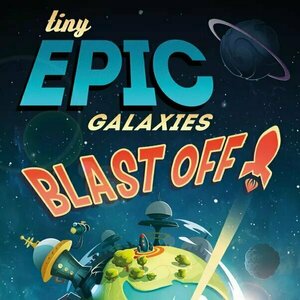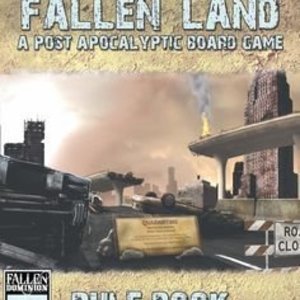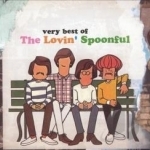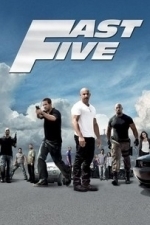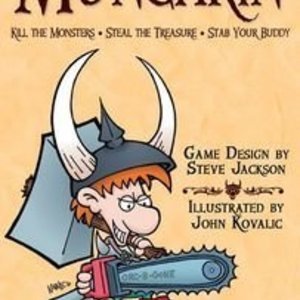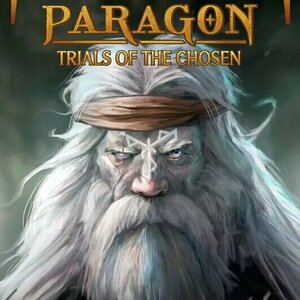
Hornet, The Gay Social Network
Communication, Photo & Video and Social Networking
App
Hornet makes it fun and easy for gay, bi, and curious guys to connect with each other. Find great...

Kashoo Cloud Accounting
Business and Finance
App
Kashoo is a simple accounting and bookkeeping app for business owners that is a great alternative to...

touchAble Mini
Music and Productivity
App
touchAble is THE controller app for Ableton Live. Countless artists around the globe - from bedroom...

Kandy Entertainment Magazine
Entertainment and Magazines & Newspapers
App
Welcome to Kandy Magazine - America's choice for a men's magazine. Made in the USA. Who loves...
Purple Phoenix Games (2266 KP) rated Tiny Epic Galaxies: BLAST OFF! in Tabletop Games
Mar 30, 2021
I will not be explaining the entire game in this review as indeed it is mostly the same game as before. However, I will be visiting some differences between this version and the original.
Firstly, the art is most certainly different. The card layouts are all different. The components are completely different. It is markedly improved for me, but I will save my gushings until the end.
Mechanics-wise, the differences are slight, but perfectly altered. For starters, many of the benefits of using planet powers have been streamlined, simplified, and make a lot of sense. Much of this has to do with iconography on the cards, but also the powers are mostly brand new. Additionally, this version rids players of the Secret Mission cards from the original. Now, I enjoyed that aspect of OG TEG, but I did not find myself pining for it whilst playing BLAST OFF! Also removed from this version is the seventh action die; BLAST OFF! comes complete with six dice total. Again, it reduces the number of actions that can be completed on a turn, but I haven’t missed that extra die. One of the greatest changes in this version is the Converter tweak. In the original game a player would need to sacrifice two inactive dice to convert a third die to whichever face was needed. In the new version, only one die is needed for sacrifice along with either one Energy or one Culture value. The Converter was always neglected in the older version, and now it’s a real option during play.
I do wish certain aspects of the older version were included, however. What has been eliminated in the streamlining process is the Solo mode and the fifth player. BLAST OFF! can accommodate two to four players now instead of one to five players, with the black components being axed from this version. I will miss the Solo mode mostly because I used to love breaking out the game later at night once the kids were asleep to try to conquer the Red rival (I almost never play Red). I do understand that a Solo mode may still be created in the future by Gamelyn directly or by another gamer.
All of these changes are minor, but equate to a much better gameplay overall. I do want to speak more on components, so let’s away with them.
Components. Okay, BLAST OFF! boasts improvements on the original game on every facet of components. Yes, the materials are similar quality, so it’s a wash there, but everything else is so much better. The dice are bigger, and ORANGE (great choice btw)! The iconography is much easier to understand and decipher throughout the game. The planets now have two new alignments: Life (plant icon) and Tech (gear icon). I feel the iconography and terminology in the first version could be confusing to new players, but plants vs gears is easy to distinguish. The ships are more stylized now, and the inclusion of this new Galaxy Slider to move up the Galaxy Track on the mats is most excellent. All of these improvements definitely cater to new Tiny Epic Galaxies players, and are most welcome as I try to convince my brother that this is one of the best games out there.
Obviously I am keeping this version and am seriously considering weeding out my original version of TEG with all expansions in favor for this. I just feel better playing it. It is more streamlined, easier to play and teach, and I love the way it looks on the table much more. One minor wish I have for the game is different player colors. This game could have been a triumph with just four different player colors from the original. Now, there’s nothing wrong with tried and true blue, yellow, green, and red, but I’m much more interested in playing a game with fuscia, purple, volt (like our green color we use throughout our branding), and aqua. Maybe it has to do with colorblindness, I don’t know, but take on the colors like are found in Seasons or something, and this game would blast off higher on my Top 10 Games of All Time list for sure.
That said, Purple Phoenix Games still gives this one a rocket of a GOLDEN FEATHER AWARD! If you are a fan of the original but wish new players to the game would enjoy it more, check out BLAST OFF! Nearly everything that has been changed caters to newer players and giving all players a more aesthetically-pleasing experience over the original. I will definitely be playing my copy a TON. Maybe if I ask nicely Gamelyn Games will make me some different player colors. Maybe.
Paul Kellett (118 KP) rated Fallen Land: A Post Apocalyptic Board Game in Tabletop Games
May 9, 2019
On first opening the box, you are greeted with a few punchboards, the game board and a ton of cards, there is a lot contained in such a small box.
After punching and organising everything, I read the rules, painted the little plastic faction tokens and made some character inventory sleeves to help keep the play area neat.
The rules are really well written and easy to follow & understand with plenty of examples and pictures. there is a helpful index on the inside back page so you can quickly find anything you need mid-game.
The first solo variant is basically just a "reach the victory point win in as few turns as possible" - a great way to quickly learn the basics of the game and very enjoyable. It will be good if you just want to play a fairly quick (60-90 minute) survival/exploration game.
The second solo rule set is where the game really kicks into high gear. You choose a number of opponent factions depending on how much of a challenge you want and during the Town Business Phase, roll a D10 for each faction, comparing the result to a chart in the book to see what each faction does. these results can boost each faction up one or both of the victory point tracks (getting to the top of either one is a win) or more importantly, initiating PvP combat against your faction.
While this is still not the same as playing against real opponents, it offers a great challenge that will test your luck and skill to beat.
So what sets this game out as a solo gem? It's one of the most immersive games I've played. It's part open-world survival boardgame, part rpg and part story book.
You are the leader of a faction of survivors following a devastating war that destroyed the US leaving pockets of survivors trying to eke out a living among the radioactive ruins. As you make your way around the map, trying to secure vital resources or checking out points of interest, you will be drawing encounter cards and trying to complete them.
You control a team of 5 characters plus a vehicle if you are lucky and start the game with 10 items (from assault rifles to baseball bats, med kits to body armour and everything in between) which you can equip to each character any way you see fit. Some characters will get a bonus if they have certain items and some items can grant boosts to your entire party.
Here is where the RPG feel comes in. Each character and Item has a row of skill attribute boxes along the bottom edge of the card with skills such as Combat, Survival, Medical, Mechanics and Diplomacy. Your character card has a maximum carrying capacity and each item a weight so your character can only carry a certain number of items.
Skill checks are simple, you add up the total values in each attribute column of your character plus his/her equipment. Every 10 is an automatic success. Then you roll a D10 and must roll equal to or lower than the unit value. So, if your combat total is 14, then you get 1 success for the 10 and then must roll 4 or less to get a second success. This makes equipping items very important as not only do you want your skills to be as high as possible, it's often preferable to store an item for later if it would result in a lower unit thus making the die roll harder.
On to the encounters. There are a lot of them. Seriously, loads and each one on them has a mini story delving into another aspect of life after 'the war'. These add so much to the feeling of being immersed in a full world and are varied and well written. Each encounter will list a series of skill checks and the number of successes you need to pass. This is Ameritrash at it's finest Read a story, roll a bunch of dice and the deal with the outcome. A successful result will see you off with a new stash of items, victory points or maybe even new characters you can rotate into your team to replace injured members or just improve your chances with better skills.
There is so much in this game, the sheer number of cards is immense. the replayability is sky high as you will never see everything this game can offer. There are character combinations that complement each other if used together (what are the chances of drawing a husband and his wife together out of a deck of over 100 cards?), locations and storylines that trigger bonus effects if you have the right gear and 10 different factions each with their own skills and bonuses.
This game is certainly not for everyone - if you don't like luck-based games then you might not enjoy the amount of dice rolling and card drawing in Fallen Land.
The art is also divisive. It's very stylized and cartoony but it works with the feel of the game. It's not a pretty experience, everything is broken and destroyed, it's a harsh, Mad Max world of brutal survival and the art on the cards kind of fits this feel and to be honest, most of it ends up covered up and you concentrate more on reading the stories and trying to survive.
All in all a great so experience and a fantastic, brutal multiplayer game.
Johnny Marr recommended track Coconut Grove by The Lovin Spoonful in Very Best of the Lovin' Spoonful by The Lovin Spoonful in Music (curated)
Gareth von Kallenbach (980 KP) rated Fast Five (2011) in Movies
Aug 7, 2019
The film quickly moves forward in time where Brian and Dominic’s sister Mia (Jordana Brewster), overall fugitives from the law, have taken refuge in Rio. Unsure of exactly where Dominic is, an old family friend offers Brian and Mia roles in a job which will surely score them some very easy and much-needed money. Although reluctant, Brian agrees to the job which involves the theft of three high-value cars from a train. Things go horribly wrong when they’re doublecrossed, the aftermath of which leads to the death of three federal agents. Only Dominic’s arrival, quick thinking, and a daring escape allows Brian and Mia to survive.
Although it is not their fault, the deaths of the agents is blamed solely on the trio, and an elite fugitive hunter named Hobbs (Dwayne Johnson) arrives with his team with the sole mission of stopping Brian, Mia and Dominic, no matter the cost.
As if this wasn’t enough trouble for the fugities, it is learned that they have also fallen on the radar of the local drug kingpin named Reyes (Joaquim de Almeida), who will stop at nothing to retrieve an item now in the trio’s possession. Caught in the crossfire between Hobbs and Reyes, Dominic plots an epic caper that will allow them not only the money to flee Hobbs and disappear into a life of luxury, but allow them to settle the score with Reyes.
What follows is a nonstop action thrill ride that sprinkles in a nice mix of comedy and romance to keep things interesting. The film downplays the racing aspect of the series and instead saves the spectacular driving for key action sequences. While street racing scenes are alluded to they are not shown as director Justin Chin focuses squarely on his cast and allows them ample time to develop their characters. In doing so it strengthens the bond between them and allows the climactic sequence to have an even greater impact than your standard over-the-top summer film action scenes.
.
There are some really funny moments in the film as Dominic assembles his team to pull off the ultimate job. The new characters work very well with the established cast from the previous films and introduce characters which I hope will be a part of any future films in the series. Johnson was a very pleasant surprise, as his character could easily have been one-dimensional. He was given a few wrinkles which allowed him to walk the fine line between good guy and bad guy, which is an essential quality to many of the film’s characters. Johnson’s action sequences were solid and highly effective and once again underscores that he needs to be focusing more on action films and less on the family-friendly genre that
has dominated the bulk of his recent work.
Walker and Diesel complement each other perfectly and appear to be having a great time working with one another again. They have a very easy-going and natural chemistry with one another that works even when they’re not behind the wheel of a car or caught up in a frantic action scene.
While the plot of the film is fairly straightforward it provides ample framework for the characters to grow and propel the story forward. While the audience is asked to take some great leaps in logic it doesn’t derail from the finished product. The stuntwork in the film was absolutely amazing and the spectacular finale of the movie alone must be seen to be believed.
Many times during my press screening the audience was completely silent for a brief second following an action sequence before erupting into thunderous applause and cheers after they’ve fully processed what just unfolded on the screen. Larger-than-life characters combined with larger-than-life action, plus some very sexy cars and very sexy people make an extremely winning formula. If the rumors are true, Chin may be handed the reins to the Terminator franchise as well as the next film in the Fast and Furious series, then audiences are in for one hell of a ride.
I think my wife summed it up best when she said that movie was “Ridiculous…ridiculously good.” Reality is thrown out the window for pure adrenaline and testosterone fueled action.
Purple Phoenix Games (2266 KP) rated Munchkin in Tabletop Games
Jan 6, 2020
In Munchkin games, you are trying to become the first player to reach 10th Level. That’s the goal. You take on the persona of a 1st Level basic human (no Starbucks jokes please) who will be adventuring with a party of your opponents through a dungeon. You will be kicking down doors, fighting monsters, placing curses on your fellow party members, and buffing yourself with cards featuring funny art and punny references. Your party mates are also trying to achieve 10th Level and will do everything they can to block your progress, so be prepared!
DISCLAIMER: This review is not for a specific game within the Munchkin universe, but for the system as a whole. All Munchkin games will pretty much use similar, if not exactly the same, rules to play the game with minor variations and different theming. I will be using The Good, The Bad, and The Munchkin for my review as it is one of the two versions I still own of the franchise. Also, I will not be detailing every rule in the book(s), but giving a brief overview of how the game plays. -T
Setup is easy: shuffle the deck of Door cards and the deck of Treasure cards. Deal cards to the players for their opening hands and keep the included die handy.
Your turn consists of just a few phases: Open a Door, Look for Trouble, Loot the Room, and Charity. To Open a Door, flip over the top card of the Door deck. If it is a monster you must fight it or run. If not a monster, you can move on to the next phase. If it IS a monster, prepare for combat. Combat is simple in that you add up all your bonuses from your gear cards you have attached to your character and try to beat the strength of the monster. Your party mates can screw with you during combat by adding strength to the monster or adding monsters to the fight to make it a more difficult encounter. If you win, you gain a Level on the spot. Some monsters are worth even more than one Level. If you did not encounter a monster, you will add the non-monster card you drew to your hand and you may Look for Trouble by playing a monster card from your hand to initiate a combat. This fight will work the same way and you will be susceptible to pile-ons as before. You may Loot the Room if you defeated a monster on your turn by drawing Treasure cards equal to the printed reward on the bottom of the monster card you defeated. If you defeated the monster yourself, unaided, these are drawn in secret. If you were given help by your mates then you may have to split up the loot per any agreements made. These cards are usually very advantageous to you so they are usually very valuable to others as they attempt to steal away your goods. If you did not fight a monster yet this turn, you may draw another secret card from the Door deck to add to your hand. Should your hand size climb above your limit (dictated by your Race card, if any) you will slide into the Charity phase to relieve your hand of extra cards. Give all excess cards to the player of lowest Level, or split them among those that share the lowest Level. It is now the next player’s turn and you continue play until someone reaches 10th Level.
Components. It’s a bunch of cards and one die. The cards are of okay quality. Nothing to write home about. The die is nice with one of the faces having the Munchkin logo head imprinted on it. It will also have a color scheme that matches the version of Munchkin you are playing, so it’s easy to match them back up if they become integrated with each other. Overall, the components are fine, but not wonderful. That’s probably why these are pretty inexpensive to purchase.
Okay, so like I said earlier the original vanilla Munchkin was the first hobby board game I ever purchased. My friends and family had no idea hobby games existed, so there was actually a pretty steep learning curve for us. Once we figured it out, however, we began to play it a ton and really love it! The cards are cute, the game play is pretty easy if you have played hobby games before, and the puns kept us rolling for a good while. There was a time when I owned every version of Munchkin in circulation and we never even played half of them. Seeing this I got rid of them through BGG Auctions. I have The Good, The Bad, and The Munchkin and Munchkin Zombies right now and I feel that will be plenty for me from here on out – unless they make a Doctor Who or Firefly set or something /*checks warehouse23 to find out if these are available/.
Do I still love Munchkin? No, not really. I LIKE it, but I don’t really want to play it all the time any more. Why? Well, as my gamer experience increases and I level up, my game tastes also level up. I see why people enjoy and even love this game system. I myself loved it for a time. But there are better games out there that accomplish the same feelings without being as sophomoric and have better choices to be made. Will I still play these games? Heck yeah! If someone asks to play a Munchkin game I am all in. I have different tastes and preferences now, but I’m no snob. Just come prepared, because I won’t go easy on you.
We at Purple Phoenix Games give this family of titles a backstabby 16 / 24.
Purple Phoenix Games (2266 KP) rated Paragon: Trials of the Chosen in Tabletop Games
Sep 18, 2021
Paragon: Trials of the Chosen (which I will lovingly refer to as Paragon from here on out) is a fantasy deck construction fighting card game where players will be outfitting their chosen avatars with awesome gear and abilities and sending them to battle against other players’ avatars. All players will know EXACTLY what is in their draw deck AND in what order because they have constructed it card by card and the deck will never be shuffled. Intrigued?
DISCLAIMER: We were provided a copy of this game for the purposes of this review. This is a retail copy of the game, so what you see in these photos is exactly what would be received in your box. I do not intend to cover every single rule included in the rulebook, but will describe the overall game flow and major rule set so that our readers may get a sense of how the game plays. For more in depth rules, you may purchase a copy online or from your FLGS. -T
To setup, each player chooses two avatars with whom they will play. Avatars belong to one or two different Disciplines, which allows players to construct their deck with Discipline-specific cards to be used during the game. As part of setup, each player will choose 20 cards from the gigantic deck of Equipment and Ability cards with which they will form their deck for play. Per the rules, each player will then place their chosen avatars and ordered decks in front of themselves along with a blue 1d10, the green 1d10 (all set to 1 to begin), and pile of Hearts tokens. Players draw their starting hand of five cards and the battle can begin!
The green 1d10 notates the round number, and the blue 1d10 per player represents their current Energy. To bring cards into play a player will spend the printed amount of Energy and track this on their 1d10.
Each round is played over several phases. The game is designed to play to 10 rounds, but players may play past 10 while keeping the round tracker and Energy static for all rounds after 10. The first phase is the Start Phase, and acts as a maintenance phase where players will activate any “Start Phase” effects from played cards, ready all exhausted cards, increase all the d10s, and draw the top card from their deck. Should a player be unable to draw a card during this phase due to the draw deck being empty, they immediately lose the game.
The second phase is the beefy Main Phase. This is where all the action happens. During this phase, players will take turns playing cards until both players have passed. On a turn a player will have the choice of five actions: Play a Card, Trigger an Activated Effect, Declare an Attack, Channel Energy, and Pass. To Play a Card the active player will pay the cost (in Energy) printed on the card and bring it into play exhausted. Cards brought into play this way will be attached to one of the avatars and act as an equipment or new ability, as long as the card played matches the Discipline of the avatar to which it is attached.
To Trigger an Activated Effect, the player will need to satisfy any qualifying conditions of the activation, which are printed on the card. These abilities can vary wildly and add immense strategy to play.
Once a player believes they have enough firepower attached to their avatars they may instead Declare an Attack by announcing their target and exhausting the card that is attacking. It is here that Paragon strays from the norm. Instead of damage simply being dealt to the opponent, the player may engage in a volley of playing Instant cards from hand (and paying their Energy costs) to add to the card stack. This is important, as the stack is then resolved in reverse order of play. So the last card to be played on the stack will be resolved first. This can result in attacks being nullified or shielded before they even proc. Sneaky and wily players will certainly use this phase wisely to draw out cards from their opponents’ hands. Once the stack is built, it is resolved and damage is calculated.
Players may instead elect to Channel Energy by exhausting one of their avatars to add 1 Energy to their pool. This may be repeated as long as the other avatar is available to be exhausted.
Lastly, and most easily, when players have no other actions they can or wish to complete, they may Pass in order to close out the round of phases.
When both players have Passed, the End Phase begins, and acts as another maintenance cleanup phase to ready players for the next round. This includes resolving any “End Phase” effects and increasing the round d10 by 1. The game ends once a player’s two avatars have been defeated or a player is unable to draw a card from their draw deck. The winner then boasts mightily in the face of their competitor and spews taunts and rematch challenges.
Components. This one is simple. Paragon has a giant stack of cards, a few d10s, and some wooden Heart tokens. The tokens are double-sided with a 1 printed on one side and a 3 on the other. These are obviously to track HP loss, and are fine. The 3d10 in this version are entry-level, and I will probably bling it out with some d10s that are more themed. The cards. Okay, I will certainly be sleeving this game. I want to keep my copy in excellent condition for as long as I can. In the last photo here, I splayed out the avatars that are currently included, and all the other cards stacked are the equipment and abilities to be attached to the avatars. I have no problems with the components in Paragon (I just want to get more exciting d10s to use).
There really is an insane amount of choice and customization that can be had in constructing a deck for the chosen avatars, and that is precisely why I mention in the opening that I have yet to understand all the components: how will I ever be able to perfect a combination that speaks to me and works with my style when I have about a zillion options available? I know many gamers will salivate over the amount of deliberation and possibilities contained in the box, and after several plays, I find myself weighing options in my head throughout the day. When you think about a game throughout the day and how you will attempt to play it next time, I feel that is a sign of a truly great game for you.
This is certainly not for everyone, but it definitely is for me. I truly cannot wait to try out different combinations, strategies, and deck configurations each time I play. I can also see Paragon being ripe for multiple expansions, with new avatars representing new Disciplines, or adding in expansion material that is themed for different IPs or historical eras. Well, I guess it is time to pick up a part-time job to fund my Paragon expansions.
If you are like me and enjoy games that offer near-infinite possibilities and the true feeling of never playing the same game twice, then Paragon needs to be on your shelf. The rules are easily-digestible, games take 30 minutes once you are familiar with it, and there are a ton of unique cards included in this box. Purple Phoenix Games gives Paragon an excited 5 / 6. I really think that with more plays and tweaks to my copy (maybe an expansion or two thrown in) this could eek up to a 6 and earn a Golden Feather Award from me. It is smooth, exciting, and just oozing with customization that many gamers are going to absolutely love. Go find yourself a copy and get it to the table right away!
